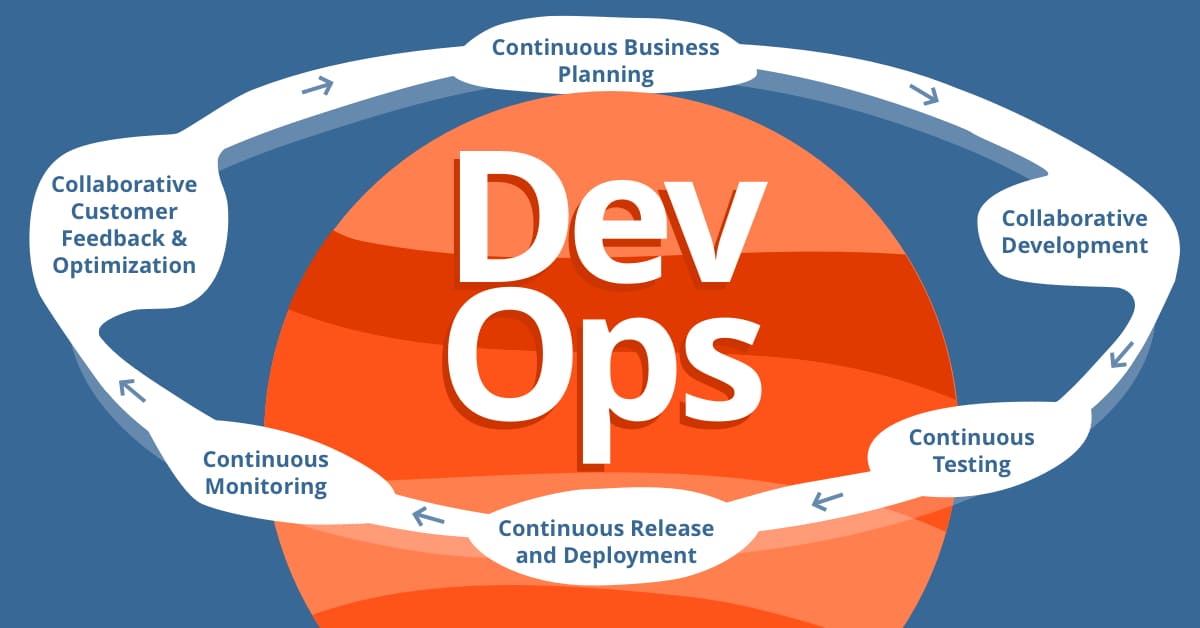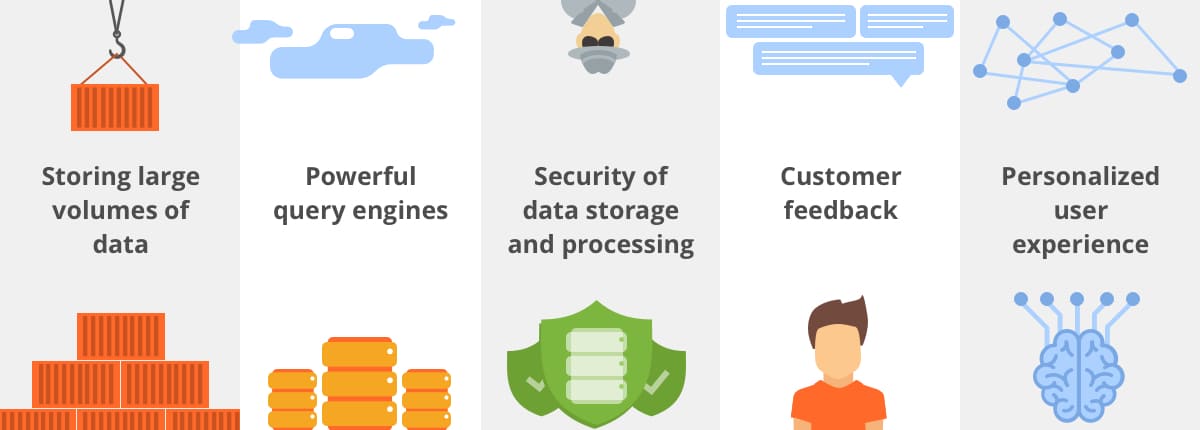Make DevOps your trump card in e-commerce competition
-
6060
-
0
-
0
-
0
E-commerce industry has to utilize the latest tech advancements to remain competitive. DevOps is one such advancement, though it is more cultural than technological.
E-commerce businesses serve their customers online. This means e-commerce companies have to support a huge IT infrastructure to enable performing several mission-critical functions:
- They have to store large volumes of data like their inventory, history of purchases, etc.
- They need to provide powerful query engine to be able to check the quantity of the goods in stock.
- They have to ensure the security of their data storage, as they keep lots of personal details and banking data of their customers.
- They must have a rapid feedback pipeline to enable continuous improvement of their services by incorporating customer feedback and development of new features
- They must leverage Artificial Intelligence and Machine Learning (AI & ML) features to provide personalized and positive customer experience. The bright example is Amazon’s “people who bought this also searched for…” feature that made them billions in consecutive sales and upsells.
All of these points have one thing in common — they require immense computational resources to work well, especially for big e-commerce platforms with millions of daily visitors. Thus said, efficient resource allocation, IT infrastructure optimization and improvement of operational workflows are essential parts of e-commerce business, as they allow saving millions of dollars and thousands of man-hours of effort. This is why implementing DevOps in e-commerce platforms can be such a crucial step for companies of all sizes across the industry.
What is DevOps and why it matters?
DevOps is a transformative approach to software delivery and IT infrastructure operations. Culturally, it is the practical implementation of Agile and Lean principles. Technologically, it is a combination of Continuous Integration (CI) of feedback, resulting in the development of new features and improvement of product; Continuous Delivery (CD) of new code to production through automated build-test-deploy pipelines; and treating your IT Infrastructure as Code (IaC), meaning the state of your existing IT systems and any required software environment is described with Kubernetes and Terraform manifests, that can be stored and versioned as any other code, on Github, Gitlab or BitBucket.
DevOps is the culture of collaboration between teams, as well as a set of DevOps tools and methods of continuous elimination of waste from business processes, leading to ever improving delivery of value to end users
Here is a brief example of a standard Waterfall software delivery pipeline:
The code is written by developers, tested by QA engineers and operated by Ops team. On each stage of its lifecycle, the code is “thrown over the wall” to become somebody else’s responsibility. The developers do not care about the operational restrictions and requirements, it’s Ops team’s task to make the code work in production. The Ops have to spend much time configuring the servers for the needs of the Devs while maintaining the infrastructure at the same time.
The Devs want to make changes to improve the product, while the Ops value the stability of operations most. The tasks and responsibilities are siloed, the goals are separate, the development process is slow and the outcomes are always uncertain.
The DevOps software delivery lifecycle is absolutely different:
The roadmap for new product development or new features implementation is built based on customer’s requirements or end users feedback. Before the code development begins, the Devs, the Ops, and the QA specialists discuss the best ways to reach the goals set, the most convenient software architecture and the most resource-effective underlying IT infrastructure needed to run this software. This is the collaborative development.
This way, the Devs know how their software must operate and interact with other modules from the beginning, and can build it accordingly. The QA specialists can write and maintain a codebase of automated unit tests, enabling the continuous testing of new code.
The Ops engineers create automated software pipelines for provisioning and configuring all the parts of the IT infrastructure required for software development. These are stored as manifests and can be updated at any time based on Devs and QA feedback, so the whole software ecosystem can be easily rebuilt with new parameters. This is the meaning of Continuous Integration/Continuous Delivery (CI/CD) DevOps principles.
Once the new code commits successfully pass the testing and staging servers, they can be seamlessly pushed into production through in-app updates, rolling updates and other delivery methods that exclude the service downtime. This enables the continuous release and deployment.
Continuous monitoring still requires lots of time and effort, yet DevOps tools like Zabbix, Prometheus, and Grafana enable the predictive monitoring, when the repetitive issues are solved BEFORE they actually occur. In addition, the analysis of data gathered this way helps identify the normal operating patterns, the existing bottlenecks and the possible security breaches. This is how AIOps works, and this is truly a whole new level of IT operations.
The last part of the never-ending cycle involves the continuous gathering of the feedback from the product stakeholders and end users, as well as from Devs and QA specialists. This feedback serves as a base for further platform improvements or IT infrastructure optimization.
Such an approach to handling IT operations and software delivery processes ensures that the attitudes are shared across the team and the goals are common, not siloed. By enabling the Devs to provision the required environments through simple commands, the Ops are able to concentrate their effort on improving the efficiency of operations and shortening the time to market for new products. This is the best possible outcome for any business, including e-commerce.
How does DevOps solve the challenges the e-commerce faces?
Below we briefly describe how transition to DevOps practices helps solve the challenges of modern e-commerce platforms.
- Storing large volumes of data becomes possible by using cloud infrastructure, which is easily managed through DevOps tools. Advanced DevOps practices and tricks like service meshes, serverless computing, cloud-native databases, etc. help design and implement cloud-agnostic infrastructures, that allow using the resources and services of AWS, Azure, GCP, DigitalOcean or other cloud providers in the most efficient way.
- Powerful query engines can be built using bespoke Big Data solutions and databases like MongoDB or Cassandra. These databases can be run on-prem too, but only using them within the DevOps workflow allows leveraging their features to the max, like enabling auto-scaling groups for distributed Cassandra clusters or enabling automated MongoDB backups with Terraform.
- Security of data storage and processing can be ensured due to the ability to enforce all the required security measures on one container, save the Kubernetes manifest with the parameters and easily scale up to cover the whole system. In addition, one must keep in mind strict security requirements like the ones GDPR imposes on all companies that handle the personal data and banking details of their customers. Leveraging DevOps workflows allows to codify these requirements and ensure there is no room for human error or malicious intent.
- Customer feedback can be used for continuous improvement of the services due to established CI/CD pipelines. When the much-requested feature is implemented in a month, not in half a year, customer satisfaction skyrockets.
- Implementing ML & AI algorithms to provide personalized user experience becomes a much easier task when the underlying infrastructure is managed through DevOps tools and best practices. ML models require lots of data for training, this data must be stored somewhere in the cloud, and these storage instances must be dynamically managed to be cost-efficient.As a DevOps-as-a-Service provider, IT Svit handles many projects that involve managing the IT infrastructure required for AI training and data processing. Through the course of these projects, we learned that DevOps tools provide much more resource management flexibility and transparency, as compared to conventional Business Intelligence tools or custom-made systems. For example, enabling the CI/CD pipelines allowed to shorten the data processing time from 22 hours to 5 minutes in one case.
Final thoughts on using DevOps in e-commerce
We hope this article was useful and interesting, as well as clearly depicting the benefits of leveraging DevOps practices in e-commerce. While these advantages might not seem unique and are pretty commonplace, they do include better operational stability, more predictable release cycle, tighter data security and better customer experience with lower expenses. These are tangible outcomes for any business, e-commerce in particular.
Would you like your e-commerce platform to become more cost-efficient and performant? Would you like it to become more user-friendly and be developed faster? DevOps services can make this happen, and IT Svit would be glad to provide them. As one of top-10 Managed Service Providers worldwide, we have ample experience and the right attitude to help you reach the business goals set, in time and under budget. Contact us, and let’s discuss your project!



